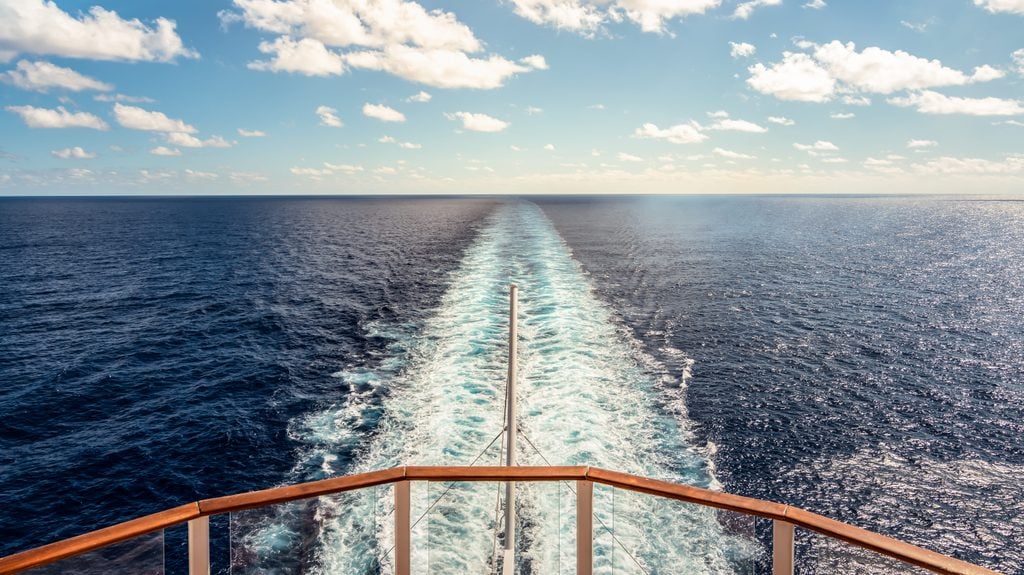How Bad Are Cruise Ships for the Environment?
Updated: Mar. 14, 2023

We know that cruises may not be good for your waistline. But are they also bad for the environment?
We love cruises as much as the next buffet-obsessed American—though as of this writing, many cruise lines have temporarily suspended operations due to coronavirus. But is it time to consider what all this cruising is doing to the environment?
Your carbon footprint is high
When you hop onto a cruise, your carbon footprint rises. In fact, every person’s carbon footprint on a cruise is about three times as high as it would be on land, according to a report by the Pacific Standard. With upwards of 3,000 passengers per ship on the larger cruises, this is a very big deal. Find out the cleanest and dirtiest cruise ships, according to the U.S. Centers for Disease Control and Prevention.
Just like planes, CO2 emissions are high
Each passenger mile on a Carnival Corp. ship emits 1.17 pounds of CO2, according to Carnival Corp.’s latest environmental report. So for example, a weeklong Western Caribbean cruise leaving from Miami and making stops in the Caribbean before arriving back in Florida would emit 2,137 pounds of CO2—or the equivalent of 18 days worth of CO2, according to Slate. Could the Unites States be carbon neutral by 2050?
Ships can cause acid rain
Ships have diesel engines or gas turbines—or a combo of the two—and these have a high sulfur content, according to Vox. Sulfur mixed with air and water forms sulfuric acid, which is the main ingredient in acid rain. This can destroy marine life, corrode buildings, and cause deforestation. The International Maritime Organization says that all ships must switch to cleaner fuel with lower sulfur content by this year—but the solution still isn’t too effective. Ships are now installing scrubbers, which clean the inexpensive fuel but dump pollutants into the water.
They emit more air pollution than cars
Sailing should be easy, breezy, right? Actually, Carnival Corporation, which owns Carnival Cruise Lines, Princess Cruises, Holland America, Cunard, and more, emitted almost ten times more sulfur oxide throughout Europe than all 260 million European cars in 2017, according to a recent analysis by sustainable transport group Transport & Environment. The report recommended that Europe implement a zero-emission port standard, in addition to extending emission control areas (they are only in the North and Baltic Seas and the English Channel) to the remainder of the European seas.
Some ships use the oceans as their trash can
In April 2019, eight Carnival companies violated their five-year probation by dumping plastic with food waste directly into the ocean (so this wasn’t the first time they did it) according to NPR. The company paid a $20 million fine and admitted guilt. And all ships are allowed to drop untreated sewage directly in the ocean, as long as they’re at least three miles offshore, though 90 percent of cruise lines have an agreement not to dump untreated sewage. Even still, Carnival Cruise Lines along with Crystal Cruises and Costa Cruises received “F” ratings in terms of sewage treatment from the 2019 Report Card.
But it’s not all bad news:
Carbon emissions are high—but they’re getting lower
The cruise lines are focusing their efforts on lowering their carbon emissions including sulfur oxide and nitrogen oxide—both of which can cause breathing issues. They’re doing this by using an exhaust gas cleaning system, which can reduce sulfur oxide levels by up to 98 percent, and can reduce nitrogen oxide levels by up to 12 percent, according to USA Today. This may have been implemented due to increased regulations that began in January: the cruise ships were required to reduce their carbon emissions.
They’re becoming more fuel-efficient
Disney Cruise Line (DCL) was the first cruise line to use what it describes as, “an innovative hull coating on its ships that is both 100 percent non-toxic to the marine environment and effective in increasing fuel efficiency by reducing surface resistance in open water.”
They’re recycling
It appears that cruises were one of the last on board (pun intended) in terms of recycling, with many ships still using single-use plastic. But last year, Norwegian Cruise Line announced that it would stop using single-use plastics in 2020, partnering with Jaden Smith’s JUST Goods Inc. The result: they’ll be eliminating more than 6 million single-use plastic water bottles annually. Likewise, DCL has eliminated plastic straws, cutlery, stirrers, shopping bags, and condiment packets on board their ships and its recycling program has eliminated more than 2,100 tons of glass, plastic, metals, and paper from traditional waste since 2014. DCL even recycles condensation that forms of the ship from the onboard air conditioning to use as laundry water and recycles its cooking oil.
Next, read on to find out 28 secrets the cruise lines won’t tell you.
